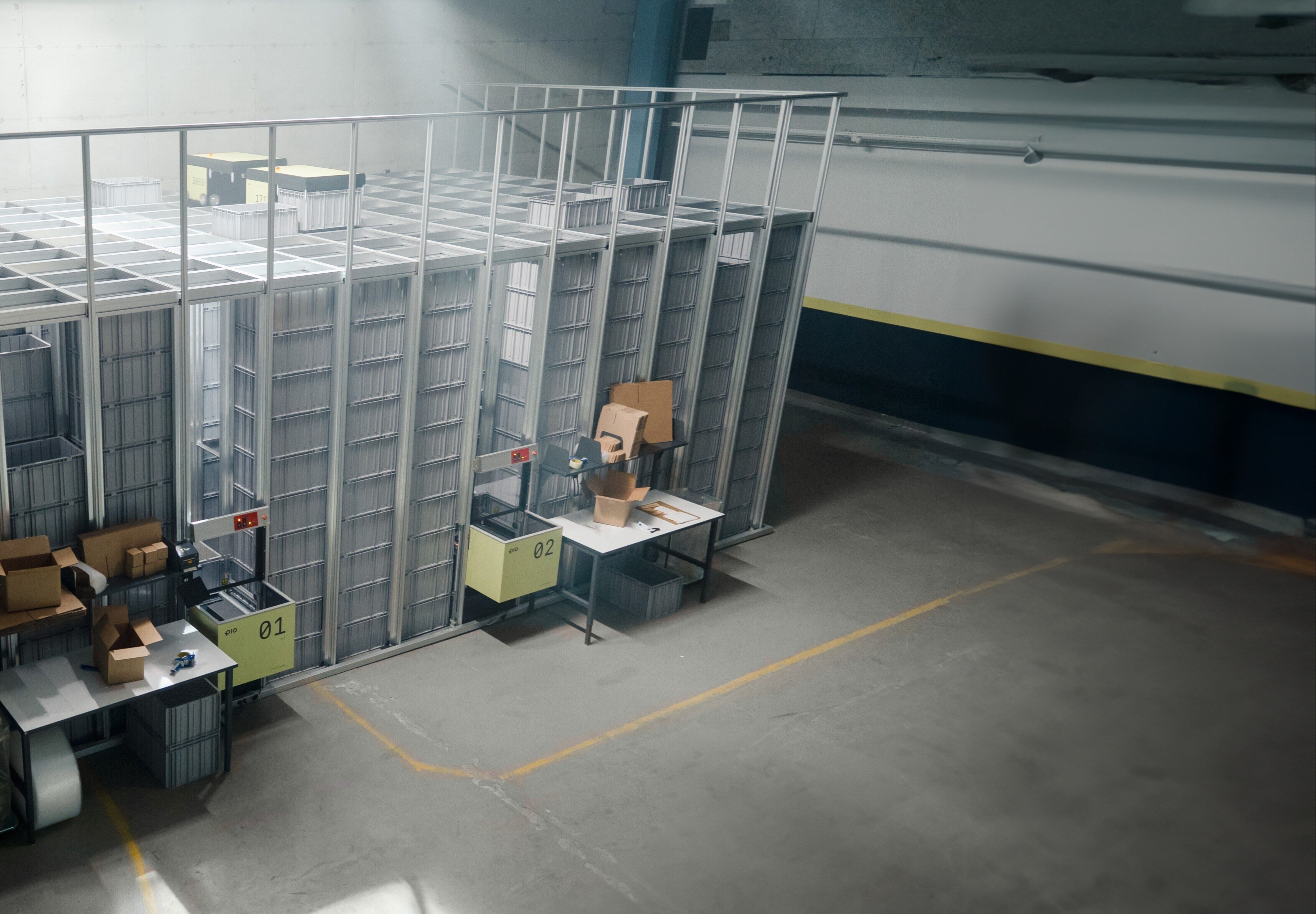The truth is that delays or errors in orders can sour customer relationships. On the other hand, an efficient warehouse system leads to good outcomes that boost customer trust and set the stage for positive feedback.
Enter warehouse technology – the driving force behind operational excellence.
In this blog, we'll dive into warehouse tech: what it involves, why it's crucial, and how you can implement it in your own warehouse.
From automated inventory systems to innovative order-picking solutions, we'll explore the transformative power of modern technology in achieving seamless warehouse operations.
What Is Smart Warehousing Technology?
Smart warehousing technology integrates advanced digital tools and solutions into warehouse operations to optimize efficiency, accuracy, and overall inventory and logistics management.
This technology leverages cutting-edge innovations like Internet of Things (IoT) devices, automation, robotics, artificial intelligence (AI), and data analytics to create intelligent and interconnected warehouse environments.
Using smart warehousing technology, warehouses can:
- Monitor inventory in real-time
- Automate routine tasks
- Enhance order accuracy
- Reduce operational costs
- Establish defined storage locations
- Adapt quickly to changing demands and business growth
Smart technology aims to streamline the entire warehouse supply chain process, from receiving goods to storing, picking, packing, and shipping them, while incorporating unit load optimization techniques. This ultimately leads to improved customer satisfaction and increased competitiveness in the market.
Examples of Smart Warehousing Technologies
In modern warehousing, a suite of advanced technologies is transforming traditional operations. These include but are not limited to:
- Warehouse Management Systems (WMS): A Warehouse Management System helps manage inventory, orders, and overall warehouse operations. It optimizes picking, packing, and shipping tasks and provides real-time visibility into inventory levels and locations.
- Automated Storage and Retrieval Systems (AS/RS): AS/RS are computer-controlled systems that automatically store and retrieve items from racks or shelves. They use robotic mechanisms or shuttles to efficiently manage inventory, minimizing manual handling.
- IoT (Internet of Things) Sensors: IoT sensors are embedded in various objects within the warehouse to gather and transmit data in real-time. They can monitor factors such as temperature, humidity, location, and movement of goods.
- Robotics and Robotic Process Automation (RPA): This involves using robots to perform tasks traditionally done by humans. RPA automates repetitive tasks such as data entry and order processing, reducing errors and improving efficiency.
- Automated sorting systems: These systems automate the sorting and categorizing goods for efficient distribution. They can significantly speed up order fulfillment and reduce manual labor.
- Conveyor systems: Conveyor systems transport goods from one point to another within the warehouse. They can be integrated with sorting mechanisms for automated order routing and distribution.
- Automatic order consolidation: This Involves gathering items from different areas of the warehouse to consolidate orders, reducing the time and effort required for manual order picking.
- Robotic packaging systems: Robotic picking systems use robotic arms equipped with sensors and cameras to handle items for order fulfillment. They can accurately select and place items into containers or boxes.
- Automated packaging and labelling: Automated packaging systems assemble and seal boxes and insert protective materials like bubble wrap. These systems also apply labels and shipping documents.

Benefits of Smart Warehouse Technology
Implementing smart warehousing technology brings many benefits and advantages that significantly enhance warehouse operations and overall supply chain management.
1. Increased Efficiency
Smart warehousing technology optimizes processes through automation, real-time visibility, and resource allocation. This translates to faster operations and reduced bottlenecks.
2. Enhanced Accuracy
Precise inventory control is achieved with IoT sensors and RFID technology, minimizing discrepancies. Automated picking and packing processes ensure higher order accuracy and customer satisfaction.
3. Cost Savings
Automation and robotics decrease reliance on manual labor, leading to ongoing cost savings. Efficient use of space also cuts down on excess storage space and expenses.
4. Scalability and Adaptability
Smart warehousing technology offers flexibility to handle increased volumes or changing demand. Real-time data allows quick adaptation to your customer demand as your business grows.
5. Data-Driven Insights
Predictive analytics and data analytics provide valuable insights. AI-driven demand forecasting optimizes inventory levels, while performance metrics drive continuous improvements.
6. Improved Customer Experience
Faster order processing and delivery result from efficient operations. Real-time tracking enhances transparency, building trust and loyalty among customers.
7. Sustainability
By efficiently managing inventory levels and minimizing excess stock, automated inventory control platforms help optimize resource use. This reduces energy consumption and waste generation, aligning with eco-friendly practices and sustainability goals.
8. Competitive Advantage
Smart warehousing sets businesses apart by offering innovative logistics solutions. Agility in operations enables quicker responses to market trends and customer needs.
9. Minimized Downtime
Predictive maintenance through IoT sensors reduces unexpected breakdowns, leading to less operational downtime and increased efficiency.
Implementing Smart Warehouse Technology
Implementing innovative technology in your warehouse involves several steps to ensure success. Here's a breakdown of the process:
- Assessment and planning: Begin by assessing your warehouse's current operations, identifying pain points, and defining objectives. Determine which areas can benefit most from the warehouse technologies.
- Technology selection: Choose the specific smart technologies that align with your goals. Ensure the selected solutions are compatible with your existing infrastructure and offer scalability.
- Provider evaluation: Research and select reputable technology providers with a proven track record in the industry. Evaluate their solutions based on your needs, budget, and long-term goals.
- Pilot implementation: Start with a small-scale pilot implementation to test the chosen technology in a controlled environment. This allows you to identify any challenges, fine-tune processes, and gather feedback from the operational team.
- Integration and Installation: Collaborate with the chosen provider to integrate the selected technology seamlessly into your warehouse infrastructure.
- Employee training: Provide comprehensive training to your workforce to ensure they understand how to operate and interact with the new technology.
- Testing and optimization: Rigorously test the technology in real operational scenarios to identify any glitches or areas for improvement.
- Data migration and integration: If applicable, migrate existing data to the new system and integrate it with your current data management processes.
- Continuous monitoring and improvement: Regularly monitor the performance of the implemented technology and gather feedback from employees.
- Scalability: Plan for scalability from the get-go. As your warehouse operations grow, ensure that the implemented technology can accommodate increased volumes and evolving needs.
Overall, a well-run warehouse becomes a strategic asset in a world where timely deliveries define business success. Enter warehouse technology - the driving force behind operational excellence.
Throughout this blog, we've explored smart warehouse technology’s importance and how it's reshaping businesses.
We've seen how technology streamlines warehouse operations from automated storage systems and inventory management software to high-density storage solutions.
The benefits are substantial: increased efficiency, accuracy, cost savings, scalability, data-driven insights, better customer experience, and much more.
%20(1).jpg?width=6889&height=4593&name=DSC00426%20(2)%20(1).jpg)
Discover Pio’s Smart Warehouse Automation Solution
Introducing Pio—an Automated Storage and Retrieval System (AS/RS) designed with a grid framework, but with a unique twist.
Pio employs a “cube” storage method, strategically optimizing your inventory storage layout, resulting in an impressive storage density and up to a 10-fold increase in warehouse capacity.
Visualize a system that not only stores your inventory but does so with meticulous efficiency. Pio's advanced technology independently navigates, selects, and delivers items right to your workstation.
This translates to processing approximately 130 order lines per hour with an exceptional accuracy rate of 99.9%.
However, Pio offers more than just efficiency. It frees up floor space, reduces staffing needs, and allows for cost-effective warehouse solutions or easy expansion.
To learn more about Pio's automated storage system, you can schedule a free strategy call with a team member to get advice from our efficiency experts. Find out exactly how Pio can transform your warehouse today.





